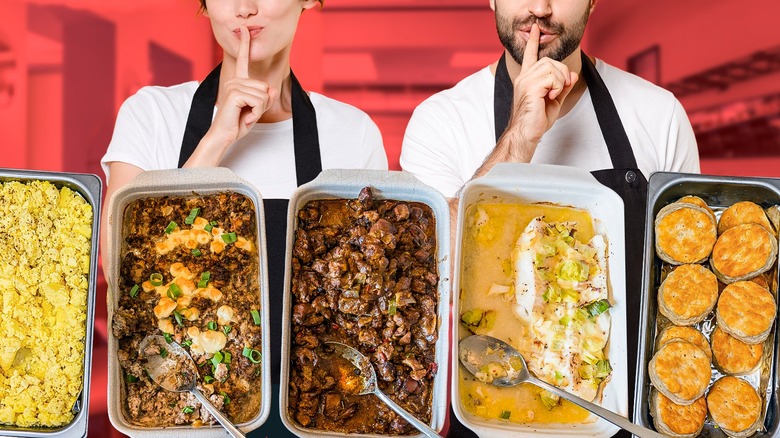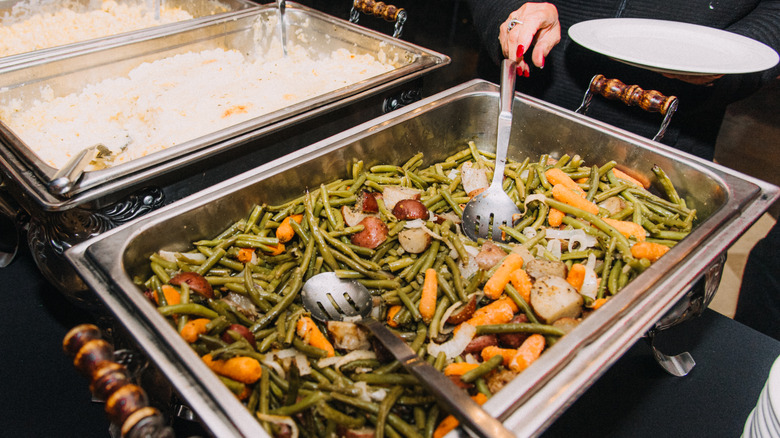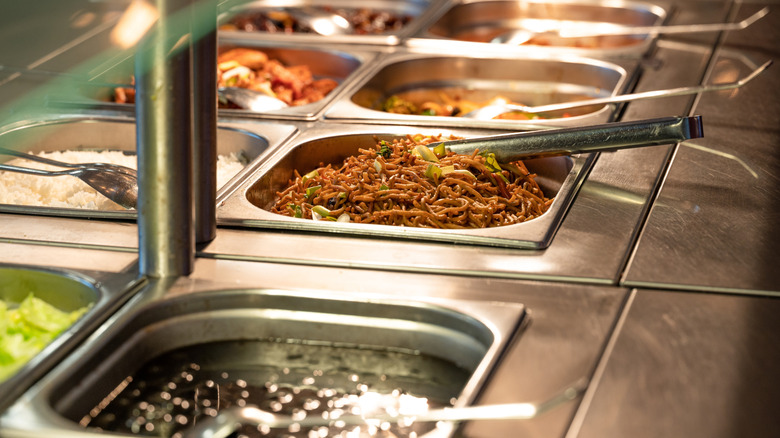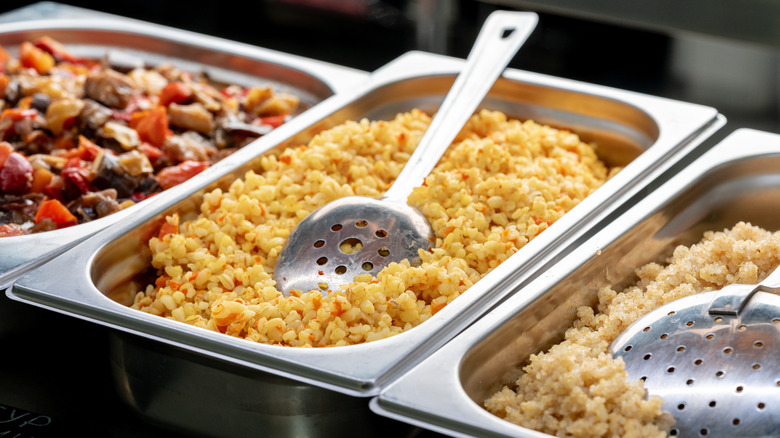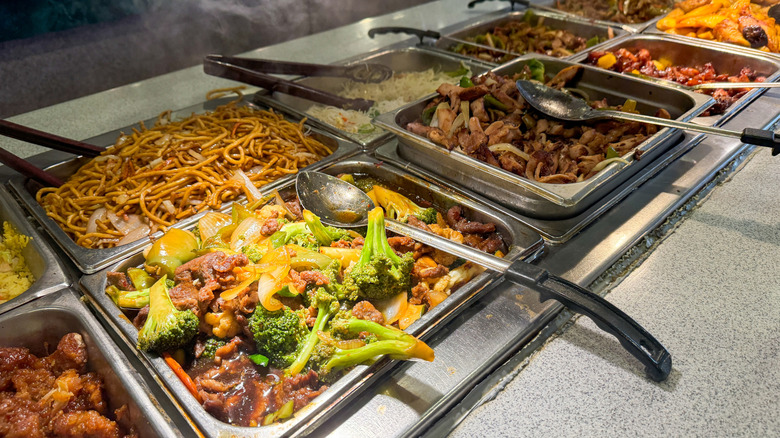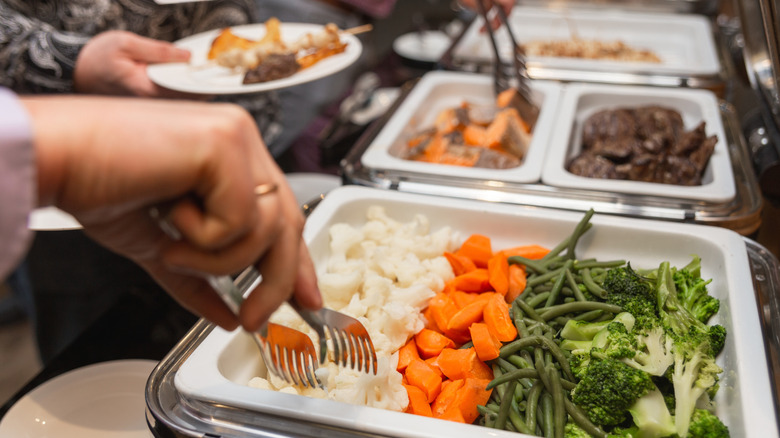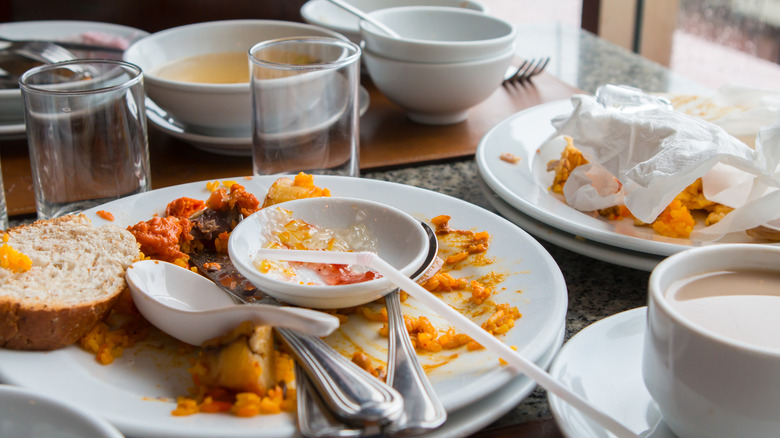All-You-Can-Eat Buffet Secrets You Never Wanted To Know
For many of us, it's hard to deny the appeal of an all-you-can-eat buffet. You walk into a room and a wide array of delicious offerings is spread out on countertops all around you, and can include anything from simple comfort food to extravagant luxuries. All you have to do is take a plate and serve yourself. Then you're free to find any table, sit down, and enjoy. The offerings are good — maybe even downright delicious — and there's plenty of variety. Even better, the reasonable, flat fee you've paid means that you can eat as much as you want.
Despite their numerous advantages, though, many all-you-can-eat buffets are serving up some dark secrets, too. We spoke with two restaurant industry experts, Danny Bendas, a Managing Partner of Synergy Restaurant Consultants, and Felicia Loo, a Food Safety Management Consultant from SFPM Consulting Inc., about some all-you-can-eat buffet secrets you never wanted to know.
They may reuse old food
An all-you-can-eat buffet should ideally sell all of the food it serves, but that's not always the case. Danny Bendas tells us that buffet owners who don't have enough customers and a lot of leftover food "may reuse products that they shouldn't in the interest of maintaining costs and avoiding waste, perhaps mixing old [food] with new."
While leftover food at home isn't a big deal (and you can even get creative with things like leftover mashed potatoes), food served at a buffet has likely already been left out a lot longer, and exposed to a lot more bacteria, making the idea of just wrapping it up and putting it back out tomorrow a lot less appealing and a lot more dangerous. Felicia Loo points out that the reused food at a buffet may not have been kept at the proper temperature to begin with, meaning that it's been growing bacteria since the first time it was served. Loo also notes that many buffets don't train their staff to follow food safety rules, so there might not be anyone qualified to make the call that an ingredient is too dangerous to be reused.
Food might be kept out for a long time
A crowded all-you-can-eat buffet can be one of the most frustrating dining experiences out there. You're battling the crowds, food and utensils may be running low, and the noise level is just about high enough to make you lose your appetite. But a busy buffet can actually be a good thing for customers, at least in one key way. Danny Bendas tells us, "When buffets are busy, the product is fresh, of great quality, and is 'turned over' very quickly." On the other hand, if business is slow, many buffet owners will leave foods and sauces out for longer than they should be, to save money.
An easy way to spot whether or not a buffet is regularly changing out its offerings, Bendas says, is to check for "crusty edges" on the food pans. Crusty edges or a skin that's formed on top of a sauce or liquid is a sign that it's been left out too long. Even fruit is something to be wary of at a buffet, if it's been sitting there for too long. The best way to be sure the food is fresh at your buffet of choice is to go at peak hours, when everything will have to be regularly replenished. "I rarely visit a buffet when it's not busy," Bendas mentions. If you can't go then, or simply don't want to battle the crowds, a good tip is to go for the popular items, because the rest has likely been sitting out for a while.
Hot or cold food might be growing bacteria
Whether it's supposed to be served hot or cold, not keeping food at the right temperature can lead to bacteria growth in a short amount of time. FDA guidelines state that in order to stave off bacteria, cold food should be kept at 40 F or lower, while hot foods should keep an internal temperature of 140 F or higher. It's undeniably important for an all-you-can-eat buffet to check the temperature of its foods on offer, and maintain those temperatures. But some may not be able to do this.
Even if they have good intentions when it comes to maintaining food temperature, buffet operators might not be aware that they're not equipped for it. For instance, while while warm food should be consistently kept at 140 F or hotter, some food warmers can only maintain temperatures of 110-120 F. Buffet owners should always check the details of a warmer before purchasing it, for this reason. When it comes to cold foods, like at a sushi buffet, these should be put on ice, but this may not be totally effective. In order to be absolutely sure that food is staying at a safe temperature, Felicia Loo advises buffet owners to "invest in good equipment, such as temperature-controlled serving stations, and ensure staff monitor food temperatures constantly."
There probably aren't enough staff
One of the things that makes all-you-can-eat buffet restaurants attractive to investors is that they require fewer staff members than a regular restaurant, since, after all, customers are serving themselves and often bussing their own tables, as well.
But Danny Bendas calls a low number of staff members "one of the biggest cost-cutting mistakes" an all-you-can-eat buffet restaurant can make. He explains that running a well-stocked buffet that meets sanitary norms requires "constant cleaning, replenishment of product offerings, [keeping] surrounding areas neat and clean, all service ware clean and restocked, constant monitoring of product temperatures to ensure all food is safe and wholesome."
Felicia Loo firmly agrees, especially as far as food safety is concerned. She tells us, "A trained staff can help implement good food safety practices that can prevent foodborne illnesses by segregating cooked and raw foods appropriately and holding food at the right temperature." So the next time you're at a buffet and don't see a lot of wait staff, be wary of things like the food quality and temperature, and just how clean your surroundings might be.
They're tricking you into eating the cheap stuff
We often think of all-you-can-eat buffets as a big way to save money — after all, the place is offering unlimited amounts of food! But buffet owners still have to make a profit, of course. If you look into resources that offer advice for buffet operators, one of the most common tips you'll come across is to save money by using customer psychology when planning the layout of a buffet.
Many buffet owners apply this strategy by putting the cheapest and most filling foods on offer at the beginning of the buffet. A study published in the journal PLOS One found that 75% of buffet-goers will take something from the first tray in the line, with 66% of the food they eat ultimately coming from a buffet's first three trays. If you want your money's worth at an all-you-can-eat buffet, make sure to continue down the line, where the more expensive stuff will be hiding in plain sight.
Many buffet owners can't budget
An all-you-can-eat buffet may seem like a well-oiled machine, especially one that's run properly. But it turns out that no matter how much they plan and study their market, many buffet owners have trouble budgeting. According to The Atlantic, anywhere from 5% to a staggering 25% of a dish put out at a buffet will go to waste. The problem could be due to the buffet operator not knowing exactly how much is needed, but it can also simply come down to customers who take more than they can eat.
Budget concerns aren't just an issue for a buffet's owner and investors. They can have a big impact on customers, too. Danny Bendas tells us, "A very accurate estimation of costs and potential volume is critical to a buffet's success". He advises buffet owners, or anyone planning to start a buffet, to remember to factor wasted food into their budget, "so that the pressure of discarding product is minimized." This prevents the need to take desperate measures like the ones on our list.
Cross contamination happens all the time
If you have a food allergy or dietary issue, you may already be aware of one of the biggest risks of eating at an all-you-can-eat buffet — cross-contamination. At buffets, foods and ingredients in separate dishes can all too easily end up mixed together, creating a major food safety issue. Felicia Loo points out that two common sources of cross-contamination at buffets are "shared utensils being used between different dishes or raw and cooked foods being placed too closely together."
Cross-contamination may seem impossible to avoid at a buffet, but fortunately, there are some ways to minimize it. Loo advises buffet operators to "Design their food station at the restaurant and traffic flow carefully to prevent cross-contamination of raw and cooked food while allowing the staff to work effectively." Customers can also minimize cross-contamination. For instance, Loo suggests that buffet-goers "always use fresh plates and utensils for each trip to the buffet to avoid cross-contamination for you and fellow guests."
Eggs can be dangerous
There are some foods people might expect to avoid at an all-you-can-eat buffet if they think they've been sitting out too long. These include seafood (especially raw seafood) and dairy-based sauces. Danny Bendas and Felicia Loo both confirm that it's best to stay away from these if they've been in their trays for a while, but Loo adds another potential threat you may not have considered: Scrambled eggs, which "dry out easily and become unsafe."
The FDA warns that leaving cooked eggs unrefrigerated for more than 2 hours makes them susceptible to bacteria growth. The risk is even higher if you're at an outdoor buffet and the temperature is above 90 F. You may think you're fine, since you'd never scoop some dried-out scrambled eggs into your plate. However, even if the eggs look and smell normal, you're still probably not in the clear, since bacteria's effects might not be noticeable right away. So, if that egg tray hasn't been changed out in a while, this is one buffet food you should probably avoid.
They're impossible to keep clean
No matter how clean and well-run an all-you-can-eat buffet is, no matter whether its food is properly prepared, served, and stored, you'll still run a risk of getting sick if you eat there. That's largely because of, well, other customers. When you read online discussions from former and current buffet workers, you'll find a common complaint: Just how unhygienic people are, and how much they disregard any rules put in place to keep food clean.
One frustrated buffet worker vented on Reddit about "disgusting customers that: use their hands, use a utensil in one unit and then use the same utensil in another unit (cross-contamination)." They added that "I've seen customers pick their nose, sneeze and cough on the food, eat food with their fingers, pick up, food smell it and put it back. The worst are kids because of their height and their faces aren't protected by sneeze guards." Sadly, this horrifying rant is far from unique. In a particularly awful example, another anonymous restaurant employee went off in a Quora thread, saying, "The utensils, with congealed gravy, caked like plaster? Forget about those, the person in front of you didn't want to hold those, after so many possibly unwashed hands. That person used their hands to pick up their food selections."
If you still want to go to an all-you-can-eat buffet after reading all that, a good idea is to choose items from food trays that have just been brought out from the kitchen. These have had less time to be exposed to fellow customers' gross behavior.
You're probably not getting your money's worth
An all-you-can-eat buffet might seem worth the health risks when you consider the reward: A cheap, limitless source of food for a fixed, reasonable price. But it turns out you probably aren't getting anywhere near your money's worth. For one thing, most of us won't eat enough at an all-you-can-eat buffet to go above the average estimated cost per customer. "Most people don't go in and beat the buffet," food expert Chef Matthew Britt told The Hustle. He added, "They eat an appropriate amount, or even less than they should, averaging out the outliers."
Anyone who's been to a buffet knows that you can't beat the system by taking home leftovers or extras, either, since the rule is that no food leaves the restaurant. A less obvious way buffets won't let you get the better of them is by selling soft drinks at a separate cost — and, usually, a huge markup. If you love buffets, don't let all of this deter you. But the next time you head inside that all-you-can-eat wonderland, reconsider what you're taking from those trays. Oh, and if you're on a budget, try to skip the soda and order water (which is usually free), instead.
